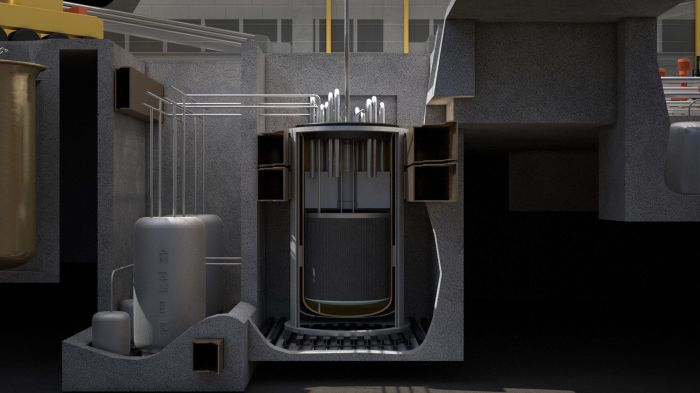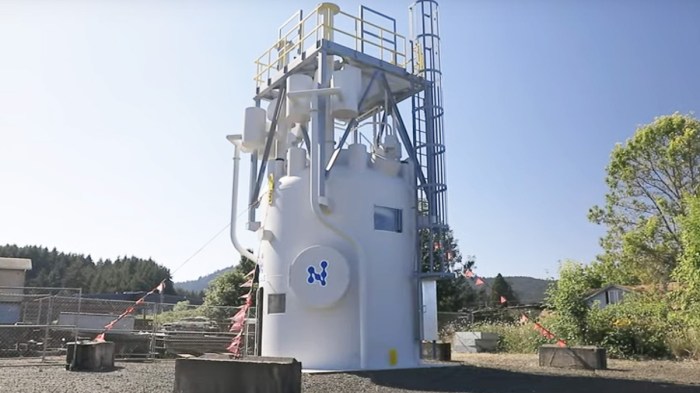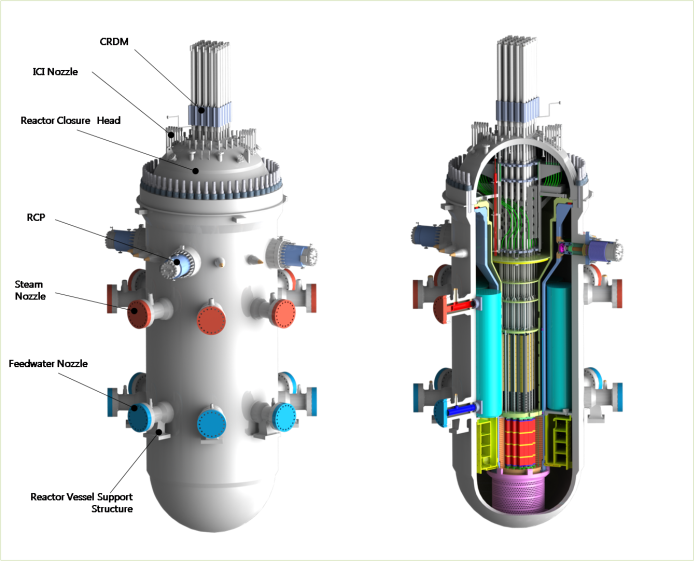Small modular reactors (SMRs) are emerging as a transformative force in the energy landscape, promising to revolutionize the way we generate and distribute electricity. These compact and efficient nuclear reactors offer a compelling solution to the challenges of climate change, energy security, and affordability.
SMRs are designed with inherent safety features and a modular construction approach, making them ideally suited for a wide range of applications, including remote communities, industrial processes, and grid-scale power generation. Their potential to decarbonize energy systems and contribute to global energy security is immense, making them a crucial technology for the future of sustainable energy.
Overview of Small Modular Reactors (SMRs)

Small Modular Reactors (SMRs) represent an innovative advancement in nuclear energy technology. Unlike traditional large-scale nuclear power plants, SMRs are designed with a compact and modular structure, enabling greater flexibility and adaptability in deployment. These reactors typically generate electricity in the range of 10 to 300 megawatts (MW), significantly lower than the gigawatt-scale output of conventional nuclear plants.The modular design of SMRs allows for prefabrication and assembly in a controlled factory setting, reducing construction time and costs compared to traditional nuclear power plants.
This approach enhances safety and quality control during the manufacturing process. Additionally, the smaller size and modularity of SMRs facilitate transportation and deployment to remote or challenging locations, expanding the potential for nuclear energy utilization.
Benefits of SMRs
SMRs offer several key benefits that make them an attractive option for future energy generation. Their compact size and modular design enable greater flexibility in siting and deployment, allowing for integration into existing power grids or remote areas with limited infrastructure.
SMRs are also designed with inherent safety features, including passive cooling systems and advanced containment structures, enhancing their resilience and reducing the risk of accidents.The modular nature of SMRs facilitates scalability, allowing for gradual capacity expansion as energy demands grow.
This flexibility enables utilities to match electricity generation with evolving demand patterns, reducing the risk of overcapacity or stranded assets. Moreover, SMRs have the potential to contribute to decarbonization efforts by providing a reliable and low-carbon source of electricity.
Challenges Associated with SMRs
Despite their potential advantages, SMRs also face certain challenges that need to be addressed for their successful deployment. One key challenge lies in the need for regulatory frameworks that specifically address the unique characteristics of SMRs. Establishing clear and efficient regulatory pathways is crucial to ensure the safe and timely deployment of this technology.Another challenge involves the economics of SMRs.
While the modular design and factory fabrication offer potential cost advantages, the overall economics of SMRs need to be carefully evaluated, considering factors such as manufacturing costs, transportation, and deployment expenses. Ensuring the competitiveness of SMRs compared to other energy sources is essential for their widespread adoption.
Applications of SMRs
Small modular reactors (SMRs) offer a versatile and adaptable solution for a wide range of energy needs. Their compact size and modular design make them particularly suitable for remote areas, decarbonization efforts, and industrial applications.
Remote Area Power Generation
SMRs can provide a reliable and cost-effective source of electricity in remote locations where traditional grid infrastructure is impractical or unavailable. They can power isolated communities, mining operations, and military bases, ensuring energy security and reducing reliance on diesel generators.
Decarbonization
SMRs play a crucial role in decarbonizing energy systems by reducing greenhouse gas emissions. They can replace fossil fuel-powered plants and provide a low-carbon alternative for industrial processes. Additionally, SMRs can generate hydrogen, a clean fuel that can be used in various applications, further contributing to decarbonization efforts.
Industrial Applications
SMRs offer unique advantages for industrial applications, including process heat, steam generation, and desalination. Their ability to provide high-temperature heat makes them ideal for energy-intensive industries such as manufacturing, chemical processing, and mining. SMRs can also provide reliable steam for power generation and district heating systems.
Safety and Regulation of SMRs
The safety of SMRs is a paramount concern, with inherent design features and regulatory frameworks in place to minimize risks. SMRs incorporate passive safety systems, such as natural circulation and gravity-driven cooling, reducing the reliance on active components and minimizing the potential for human error.
Design Considerations
- Compact Size:SMRs’ smaller size limits the potential release of radioactive materials in the event of an accident.
- Redundancy:Multiple layers of safety systems provide backup in case of component failures.
- Containment:Robust containment structures prevent the release of radioactive materials into the environment.
- Passive Cooling:Natural circulation and gravity-driven cooling systems ensure heat removal even without external power.
Regulatory Framework, Small modular reactors
SMRs are subject to rigorous regulatory oversight by national and international agencies, such as the Nuclear Regulatory Commission (NRC) in the United States and the International Atomic Energy Agency (IAEA). These regulations cover design, construction, operation, and decommissioning, ensuring compliance with safety standards.
Ongoing Research and Development
Research and development efforts continue to enhance SMR safety, including:
- Advanced Materials:Developing stronger and more corrosion-resistant materials for reactor components.
- Digital Technologies:Utilizing digital systems for monitoring and control, improving reliability and reducing human error.
- Severe Accident Analysis:Studying extreme scenarios to develop mitigation strategies and improve safety margins.
Economic Considerations of SMRs: Small Modular Reactors
Small modular reactors (SMRs) offer potential economic benefits compared to traditional large-scale nuclear power plants. Their smaller size and modular design allow for factory fabrication and assembly, reducing construction costs and timelines. SMRs also have lower operating costs due to their simplified design and reduced staffing requirements.
Cost Structure of SMRs
The cost of an SMR project typically includes capital costs (construction, equipment, engineering), fuel costs, operating and maintenance (O&M) costs, and decommissioning costs. Capital costs account for the majority of the initial investment, while fuel costs are an ongoing expense.
O&M costs include labor, materials, and maintenance activities, while decommissioning costs cover the expenses of safely shutting down and dismantling the reactor at the end of its operating life.
Comparison to Other Energy Sources
The cost of electricity from SMRs is competitive with other low-carbon energy sources such as wind and solar power. SMRs have the advantage of providing reliable baseload power, which is essential for maintaining grid stability. Additionally, SMRs have lower fuel costs than fossil fuel-based power plants, resulting in lower operating costs over the long term.
Impact on Energy Markets
The deployment of SMRs could have a significant impact on energy markets. SMRs can provide a flexible and reliable source of power that can complement intermittent renewable energy sources. They can also help to reduce the reliance on fossil fuels, contributing to the transition to a low-carbon energy future.
Future Prospects of SMRs

Small modular reactors (SMRs) are an emerging technology with the potential to revolutionize the nuclear industry. They are smaller and more affordable than traditional nuclear reactors, making them more accessible to a wider range of countries and communities. SMRs are also designed to be safer and more efficient than traditional reactors, making them a more attractive option for meeting the world’s growing energy needs.The future of SMRs is bright.
The International Atomic Energy Agency (IAEA) estimates that there will be 100 SMRs in operation by 2030. This growth is being driven by a number of factors, including the increasing demand for clean energy, the rising cost of fossil fuels, and the growing concerns about climate change.However, there are still a number of challenges that need to be addressed before SMRs can become a mainstream technology.
These challenges include:
- The high cost of developing and deploying SMRs
- The need for new regulations and safety standards
- The public’s perception of nuclear power
Despite these challenges, SMRs have the potential to make a significant contribution to global energy security. They are a clean, safe, and affordable source of energy that can help to reduce our dependence on fossil fuels and mitigate the effects of climate change.
Challenges and Opportunities for SMRs
The development and deployment of SMRs face a number of challenges, including:
- The high cost of developing and deploying SMRs
- The need for new regulations and safety standards
- The public’s perception of nuclear power
The high cost of developing and deploying SMRs is a major challenge. SMRs are more complex than traditional nuclear reactors, and they require specialized materials and manufacturing processes. This makes them more expensive to build than traditional reactors.The need for new regulations and safety standards is another challenge.
SMRs are a new technology, and there are no existing regulations or safety standards that specifically apply to them. This means that new regulations and standards will need to be developed before SMRs can be deployed on a commercial scale.The public’s perception of nuclear power is another challenge.
Nuclear power has a negative image in the minds of many people, and this can make it difficult to gain public support for SMRs.Despite these challenges, there are also a number of opportunities for SMRs. These opportunities include:
- The increasing demand for clean energy
- The rising cost of fossil fuels
- The growing concerns about climate change
The increasing demand for clean energy is a major opportunity for SMRs. The world is facing a growing energy crisis, and SMRs can provide a clean and reliable source of energy.The rising cost of fossil fuels is another opportunity for SMRs.
Fossil fuels are becoming increasingly expensive, and this is making SMRs a more attractive option.The growing concerns about climate change are also an opportunity for SMRs. SMRs can help to reduce our dependence on fossil fuels and mitigate the effects of climate change.
Potential for SMRs to Contribute to Global Energy Security
SMRs have the potential to make a significant contribution to global energy security. They are a clean, safe, and affordable source of energy that can help to reduce our dependence on fossil fuels and mitigate the effects of climate change.SMRs can be deployed in a variety of locations, including remote areas and small communities.
This makes them a more accessible source of energy than traditional nuclear reactors.SMRs are also more affordable than traditional nuclear reactors. This makes them a more attractive option for countries and communities that are looking to reduce their energy costs.SMRs can help to reduce our dependence on fossil fuels.
Fossil fuels are a major source of greenhouse gas emissions, and they are contributing to climate change. SMRs can provide a clean and reliable source of energy that can help to reduce our dependence on fossil fuels.SMRs can help to mitigate the effects of climate change.
Climate change is a major threat to the global environment, and it is causing a number of serious problems, including rising sea levels, more extreme weather events, and changes in plant and animal life. SMRs can help to reduce our dependence on fossil fuels and mitigate the effects of climate change.
Conclusion

As the world grapples with the urgent need for clean and reliable energy sources, SMRs stand poised to play a pivotal role. Their compact size, enhanced safety, and adaptability make them a promising solution for meeting the growing demand for electricity while reducing our reliance on fossil fuels.
With ongoing research and development, SMRs are poised to revolutionize the energy sector and pave the way for a more sustainable and secure energy future.
General Inquiries
What are the key benefits of SMRs?
SMRs offer numerous advantages, including enhanced safety, reduced construction time and costs, scalability, and the ability to provide reliable and affordable power in remote areas.
How do SMRs contribute to decarbonization?
SMRs generate electricity without greenhouse gas emissions, making them a valuable tool for reducing carbon footprint and mitigating climate change.
What is the current state of SMR development?
SMRs are still in the early stages of development, but several pilot projects are underway worldwide, and commercial deployment is expected in the coming years.